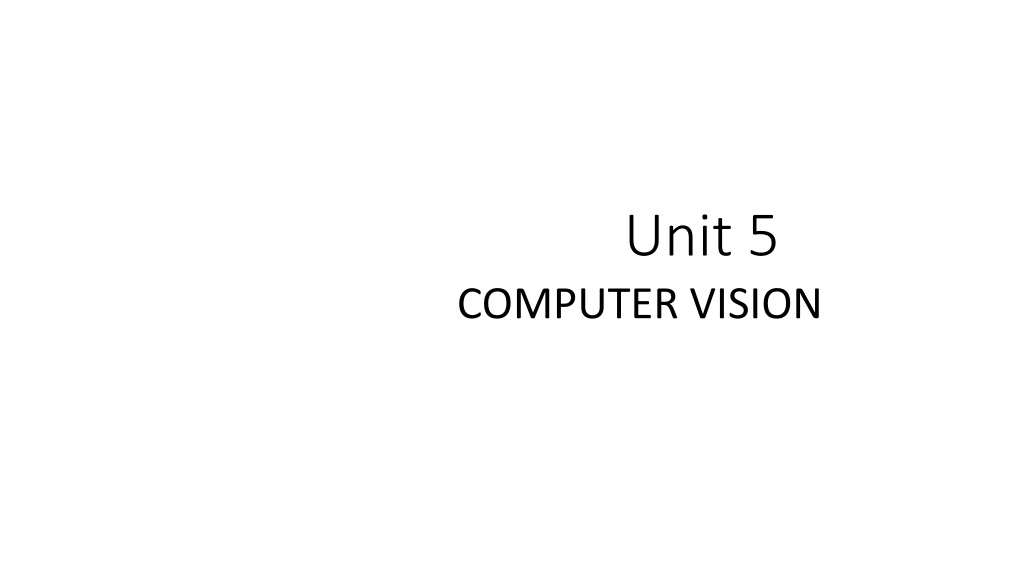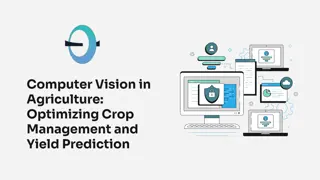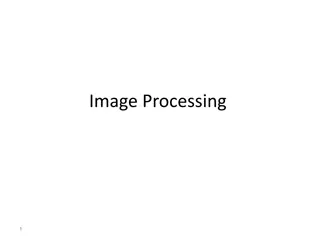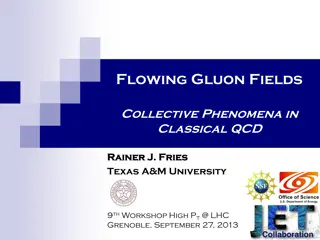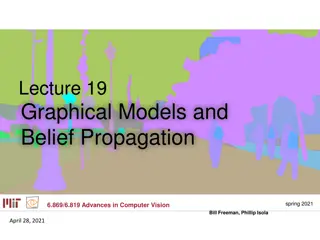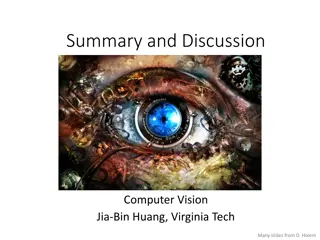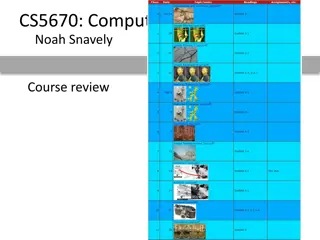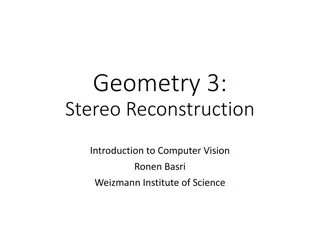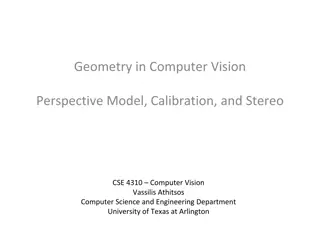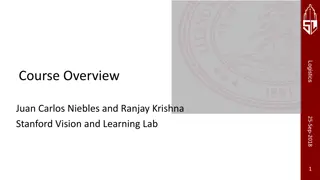Applications of Computer Vision in Various Fields
The Computer Vision domain of Artificial Intelligence allows machines to process and analyze visual data through algorithms. From facial recognition for security and attendance systems to face filters in modern apps, and from Google's Search by Image feature to applications in retail, self-driving cars, and medical imaging, Computer Vision has a wide range of practical uses across different industries.
Download Presentation

Please find below an Image/Link to download the presentation.
The content on the website is provided AS IS for your information and personal use only. It may not be sold, licensed, or shared on other websites without obtaining consent from the author.If you encounter any issues during the download, it is possible that the publisher has removed the file from their server.
You are allowed to download the files provided on this website for personal or commercial use, subject to the condition that they are used lawfully. All files are the property of their respective owners.
The content on the website is provided AS IS for your information and personal use only. It may not be sold, licensed, or shared on other websites without obtaining consent from the author.
E N D
Presentation Transcript
Unit 5 COMPUTER VISION
Introduction Introduction The Computer Vision domain of Artificial Intelligence, enables machines to see through images or visual data, process and analyse them on the basis of algorithms and methods in order to analyse actual phenomena with images. Emoji Scavenger Hunt : https://emojiscavengerhunt.withgoogle.com/
Applications of Computer Vision Applications of Computer Vision The concept of computer vision was first introduced in the 1970s. 1. Facial Recognition: With the advent of smart cities and smart homes, Computer Vision plays a vital role in making the home smarter. Security being the most important application involves use of Computer Vision for facial recognition. It can be either guest recognition or log maintenance of the visitors. It also finds its application in schools for an attendance system based on facial recognition of students.
2. Face Filters: The modern-day apps like Instagram and snapchat have a lot of features based on the usage of computer vision. The application of face filters is one among them. Through the camera the machine or the algorithm is able to identify the facial dynamics of the person and applies the facial filter selected. 3. Google s Search by Image: The maximum amount of searching for data on Google s search engine comes from textual data, but at the same time it has an interesting feature of getting search results through an image. This uses Computer Vision as it compares different features of the input image to the database of images and give us the search result while at the same time analysing various features of the image.
4. Computer Vision in Retail: Retailers can use Computer Vision techniques to track customers movements through stores, analyse navigational routes and detect walking patterns. Inventory Management is another such application. Through security camera image analysis, a Computer Vision algorithm can generate a very accurate estimate of the items available in the store. Also, it can analyse the use of shelf space to identify suboptimal configurations and suggest better item placement. 5. Self-Driving Cars: Computer Vision is the fundamental technology behind developing autonomous vehicles. Most leading car manufacturers in the world are reaping the benefits of investing in artificial intelligence for developing on-road versions of hands-free technology. This involves the process of identifying the objects, getting navigational routes and also at the same time environment monitoring.
6.Medical Imaging: For the last decades, computer- supported medical imaging application has been a trustworthy help for physicians. It doesn t only create and analyse images, but also becomes an assistant and helps doctors with their interpretation. The application is used to read and convert 2D scan images into interactive 3D models that enable medical professionals to gain a detailed understanding of a patient s health condition. 7.Google Translate App: All you need to do to read signs in a foreign language is to point your phone s camera at the words and let the Google Translate app tell you what it means in your preferred language almost instantly. By using optical character recognition to see the image and augmented reality to overlay an accurate translation, this is a convenient tool that uses Computer Vision.
Computer Vision: Getting Started Computer Vision: Getting Started Computer Vision is a domain of Artificial Intelligence, that deals with the images. It involves the concepts processing and machine learning models to build a Computer application. Computer Vision Tasks :The various applications of Computer Vision are based on a certain number of tasks which are performed to get certain information from the input image which can be directly used for prediction or forms the base for further analysis. The tasks used in a computer vision application are : of image Vision based
Classification :Image Classification problem is the task of assigning an input image one label from a fixed set of categories. This is one of the core problems in CV that, despite its simplicity, has a large variety of practical applications. Classification + Localisation :This is the task which involves both processes of identifying what object is present in the image and at the same time identifying at what location that object is present in that image. It is used only for single objects. Object Detection :Object detection is the process of finding instances of real- world objects such as faces, bicycles, and buildings in images or videos. Object detection algorithms typically use extracted features and learning algorithms to recognize instances of an object category. It is commonly used in applications such as image retrieval and automated vehicle parking systems. Instance Segmentation: Instance Segmentation is the process of detecting instances of the objects, giving them a category and then giving each pixel a label on the basis of that. A segmentation algorithm takes an image as input and outputs a collection of regions (or segments).
Basics of Images Basics of Images Basics of Pixels :The word pixel means a picture element. Every photograph, in digital form, is made up of pixels. They are the smallest unit of information that make up a picture. Usually round or square, they are typically arranged in a 2-dimensional grid. In the image, one magnified many times over so that you can see its individual composition in pixels. As you can see, the pixels approximate the actual image. The more pixels you have, the more closely the image resembles the original. portion has been
Resolution The number of pixels in an image is sometimes called the resolution. When the term is used to describe pixel count, one convention is to express resolution as the width by the height, for example a monitor resolution of 1280 1024. This means there are 1280 pixels from one side to the other, and 1024 from top to bottom. Another convention is to express the number of pixels as a single number, like a 5 mega pixel camera (a megapixel is a million pixels). This means the pixels along the width multiplied by the pixels along the height of the image taken by the camera equals 5 million pixels. In the case of our 1280 1024 monitors, it could also be expressed as 1280 x 1024 = 1,310,720, or 1.31 megapixels. Pixel value Each of the pixels that represents an image stored inside a computer has a pixel value which describes how bright that pixel is, and/or what colour it should be. The most common pixel format is the byte image, where this number is stored as an 8-bit integer giving a range of possible values from 0 to 255. Typically, zero is to be taken as no colour or black and 255 is taken to be full colour or white. Why do we have a value of 255 ? In the computer systems, computer data is in the form of ones and zeros, which we call the binary system. Each bit in a computer system can have either a zero or a one. Since each pixel uses 1 byte of an image, which is equivalent to 8 bits of data. Since each bit can have two possible values which tells us that the 8 bit can have 255 possibilities of values which starts from 0 and ends at 255.
Grayscale Images Grayscale Images Grayscale images are images which have a range of shades of gray without apparent colour. The darkest possible shade is black, which is the total absence of colour or zero value of pixel. The lightest possible shade is white, which is the total presence of colour or 255 value of a pixel . Intermediate shades of gray are represented by equal brightness levels of the three primary colours. A grayscale has each pixel of size 1 byte having a single plane of 2d array of pixels. The size of a grayscale image is defined as the Height x Width of that image.
Here is an example of a grayscale image. as you check, the value of pixels are within the range of 0- 255.The computers store the images we see in the form of these numbers.
RGB RGB Images Images All the images that we see around are coloured images. These images are made up of three primary colours Red, Green and Blue. All the colours that are present can be made by combining different intensities of red, green and blue. https://www.w3schools.com/colors/colors_rgb.asp.
Every RGB image is stored in the form of three different channels called the R channel, G channel and the B channel. Each plane separately has a number of pixels with each pixel value varying from 0 to 255. All the three planes when combined together form a colour image. This means that in a RGB image, each pixel has a set of three different values which together give colour to that particular pixel. Go to the www.piskelapp.com and create your own pixel art. Try and make a GIF using the online app for your own pixel art following link
